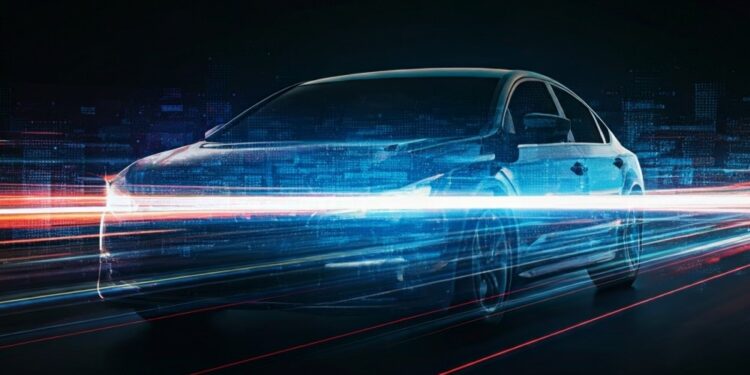The dream of a self-driving car, once relegated to the realm of science fiction, is rapidly becoming a reality. This transformative innovation, also known as autonomous driving, has been a convergence of advancements in artificial intelligence (AI), sensor technology, connectivity, and automotive engineering. Tt’s poised to revolutionize transportation, has a rich history spanning decades of innovation and experimentation. From early concepts to sophisticated artificial intelligence systems, the evolution of self-driving technology is a testament to human ingenuity and a relentless pursuit of safer, more efficient mobility.
History of autonomous vehicles
The journey of self-driving vehicles dates back to the mid-20th century, long before the term “artificial intelligence” became commonplace. In the 1920s and 1930s, engineers began experimenting with radio-controlled cars, laying the foundation for later advancements. However, it wasn’t until the advent of digital computing in the 1950s that more sophisticated concepts of autonomy emerged.
Early concepts and precursors (Pre-20th century to Mid-20th century)
The notion of automated transportation predates the invention of the automobile itself. In the late 15th century, Leonardo da Vinci sketched designs for a self-propelled cart, a testament to the enduring fascination with automated movement. While this remained a concept on paper, it illustrates the long-standing human desire to automate transportation. In the late 18th century, Nicolas-Joseph Cugnot’s invention of the steam-powered “Fardier,” designed to transport heavy cannons, marked an early attempt at mechanized, albeit not autonomous, vehicle propulsion.
These early endeavors, while not directly related to modern self-driving technology, laid the groundwork for future innovations in vehicle engineering and automation. The 20th century witnessed the first tangible steps towards autonomous driving. In the 1920s, radio-controlled cars emerged as novelties, showcasing the potential for remote control. However, these were far from true autonomous vehicles, relying on external human input for navigation.
A significant milestone arrived in 1939 at the New York World’s Fair, where General Motors showcased the “Futurama” exhibit, featuring a vision of automated highways with cars guided by embedded radio signals. This futuristic concept, while not immediately realizable, sparked public imagination and fueled interest in automated driving.
The dawn of computer vision and robotics (Mid-20th century to Late 20th century)
The advent of computers and robotics in the mid-20th century provided the necessary tools for more sophisticated approaches to autonomous driving. In the 1950s, advancements in computer science and cybernetics laid the theoretical foundations for artificial intelligence and machine learning, crucial components of modern self-driving systems. The 1960s saw the emergence of early experimental autonomous vehicles.
Researchers at Stanford University developed the Stanford Cart, a mobile robot equipped with cameras and basic computer vision algorithms, capable of navigating simple indoor environments. This project, while limited in scope, demonstrated the feasibility of using computer vision for autonomous navigation. In the 1970s, Japan’s Tsukuba Mechanical Engineering Laboratory developed an early autonomous car that used two cameras and analog computer processing to interpret its surroundings.
This marked a significant step towards real-world autonomous driving, albeit with limited capabilities. The 1980s and 1990s witnessed increased research and development in autonomous driving, with significant contributions from both academia and industry. Carnegie Mellon University’s Navlab project produced a series of autonomous vehicles capable of navigating various terrains, including paved roads and off-road environments. These vehicles utilized advanced sensor technologies, such as lidar and radar, to perceive their surroundings.
In Europe, the EUREKA Prometheus Project, a large-scale collaborative research initiative involving car manufacturers and research institutions, focused on developing autonomous driving technologies for highway driving. This project contributed significantly to the development of lane keeping assistance, adaptive cruise control, and other advanced driver-assistance systems (ADAS).
The rise of advanced driver-assistance systems (Late 20th century to Early 21st century)
The late 20th and early 21st centuries saw the gradual introduction of ADAS features into production vehicles. These systems, while not fully autonomous, provided drivers with increasing levels of assistance, paving the way for future autonomous driving technologies. Key ADAS features include:
- Anti-lock Braking System (ABS): Prevents wheel lockup during braking, improving steering control.
- Electronic Stability Control (ESC): Helps maintain vehicle stability by detecting and mitigating skids.
- Adaptive Cruise Control (ACC): Automatically adjusts vehicle speed to maintain a safe following distance from other vehicles.
- Lane Departure Warning (LDW): Warns drivers if they unintentionally drift out of their lane.
- Lane Keeping Assist (LKA): Provides steering assistance to keep the vehicle within its lane.
- Blind Spot Monitoring (BSM): Detects vehicles in the driver’s blind spots.
These ADAS features, while primarily designed to assist human drivers, laid the technological foundation for more advanced autonomous driving systems.
The DARPA Grand Challenge and the dawn of modern autonomous driving (Early 21st century)
A pivotal moment in the history of self-driving technology arrived with the DARPA Grand Challenge, a series of autonomous vehicle competitions organized by the U.S. Defense Advanced Research Projects Agency (DARPA). The first Grand Challenge, held in 2004, challenged teams to build autonomous vehicles capable of navigating a 150-mile off-road course. While no vehicle completed the course in the inaugural event, it sparked significant interest and investment in autonomous driving technology.
The 2005 DARPA Grand Challenge saw five vehicles successfully complete a 132-mile desert course, demonstrating the rapid progress being made in autonomous navigation. The 2007 DARPA Urban Challenge, which focused on navigating simulated urban environments with traffic and intersections, further accelerated the development of autonomous driving technologies. These challenges spurred innovation in key areas such as:
- Sensor fusion: Combining data from multiple sensors (lidar, radar, cameras) to create a comprehensive understanding of the vehicle’s surroundings.
- Path planning: Developing algorithms to generate safe and efficient driving trajectories.
- Object detection and tracking: Identifying and tracking other vehicles, pedestrians, and obstacles.
The DARPA Grand Challenge events played a crucial role in bringing autonomous driving technology to the forefront of public awareness and attracting significant investment from both industry and government.
The age of artificial intelligence and deep learning (Mid-2010s to present)
The mid-2010s marked a turning point in the evolution of self-driving technology, with the rise of artificial intelligence (AI) and deep learning. These technologies have enabled significant advancements in areas such as object recognition, scene understanding, and decision-making. Deep learning, a subset of machine learning that uses artificial neural networks with multiple layers, has proven particularly effective in processing large amounts of sensor data and extracting complex patterns.
This has led to significant improvements in the accuracy and robustness of object detection and tracking systems. Companies like Waymo, Tesla, and others have invested heavily in developing autonomous driving systems based on deep learning. These systems are capable of learning from vast amounts of real-world driving data, enabling them to handle increasingly complex and dynamic driving scenarios.
Core technologies enabling self-driving cars
Self-driving vehicles rely on a complex interplay of technologies to perceive their environment, make decisions, and execute maneuvers. Key components include:
- Perception systems:
- Lidar (Light Detection and Ranging): Uses laser pulses to create 3D maps of the environment, essential for identifying obstacles and road features.
- Cameras: Provide high-resolution images for object detection, lane recognition, and traffic signal interpretation.
- Radar: Measures the speed and distance of surrounding objects, complementing lidar and cameras.
- Ultrasonic sensors: Used for short-range detection, crucial for parking and low-speed maneuvers.
- Localization and mapping:
- GPS and inertial measurement units (IMUs) are combined with high-definition maps to pinpoint a vehicle’s position.
- Simultaneous Localization and Mapping (SLAM) algorithms dynamically update maps as the vehicle navigates.
- Artificial intelligence and machine learning:
- Deep learning models analyze sensor data to identify objects, predict movements, and make real-time decisions.
- Reinforcement learning optimizes driving strategies through simulation and real-world feedback.
- Connectivity:
- Vehicle-to-Everything (V2X) communication enables cars to exchange information with infrastructure, other vehicles, and pedestrians.
- Cloud-based systems provide updates on traffic, weather, and route optimization.
- Control systems:
- Algorithms govern acceleration, braking, and steering to ensure smooth and safe operation.
- Redundancy and fail-safe mechanisms enhance reliability.
Levels of autonomous driving
The Society of Automotive Engineers (SAE) has defined six levels of driving automation, ranging from 0 (no automation) to 5 (full automation):
- Level 0 (No automation): The driver is fully responsible for all driving tasks.
- Level 1 (Driver assistance): The vehicle can assist with either steering or acceleration/deceleration (e.g., adaptive cruise control, lane keeping assist).
- Level 2 (Partial automation): The vehicle can control both steering and acceleration/deceleration simultaneously (e.g., Tesla Autopilot in some limited scenarios), but the driver must remain attentive and ready to intervene.
- Level 3 (Conditional automation): The vehicle can handle all driving tasks under certain conditions, but the driver must be ready to take over when requested by the system.
- Level 4 (High automation): The vehicle can handle all driving tasks in specific environments (e.g., geofenced areas) without requiring driver intervention.
- Level 5 (Full automation): The vehicle can handle all driving tasks in all environments and conditions without requiring any human input.
Currently, no commercially available vehicles have achieved Level 5 autonomy. However, several companies are actively developing Level 4 systems for specific applications, such as robotaxis and autonomous delivery services.
Challenges and controversies
Despite remarkable progress, the path to widespread adoption of self-driving cars is fraught with challenges:
- Technical hurdles:
- Adapting to unpredictable human behavior and complex urban environments remains a significant obstacle.
- Achieving fail-proof perception in adverse weather conditions, such as heavy rain or snow, is difficult.
- Regulatory and ethical Issues:
- Policymakers grapple with setting standards for testing, liability, and data privacy.
- Ethical dilemmas, such as decision-making in accident scenarios, complicate deployment.
- Public acceptance:
- Trust and comfort levels among potential users vary, influenced by safety incidents and media narratives.
- Cost and scalability:
- Developing and manufacturing self-driving systems is expensive, hindering affordability.
- Integrating autonomous vehicles with existing transportation infrastructure requires significant investment.
Future prospects
The future of self-driving technology is both promising and uncertain. Potential developments include:
- Improved sensor technology:
- Developing more robust and reliable sensors that can operate in all weather conditions.
- Enhanced AI models:
- Advances in AI will enable vehicles to better interpret nuanced scenarios and improve decision-making.
- V2X communication:
- Enabling communication between vehicles and infrastructure (V2I) and other vehicles (V2V) to improve traffic flow and safety.
- Widespread deployment of Level 4 and 5 vehicles:
- As technology matures, fully autonomous cars may become commonplace, initially in controlled environments like campuses or urban centers.
- Integration with smart cities:
- Autonomous vehicles will synergize with smart infrastructure, enhancing traffic management and reducing congestion.
- Revolutionizing industries:
- Logistics and delivery sectors will benefit from autonomous fleets, reducing costs and increasing efficiency.
- Environmental impact:
- Electric self-driving cars can contribute to sustainability by reducing emissions and optimizing energy consumption.
Conclusion
The evolution of self-driving technology is a remarkable journey marked by innovation, challenges, and societal implications. A true testament to human ingenuity and the relentless pursuit of safety, efficiency, and convenience in transportation. While the road ahead is complex, the potential benefits – safer roads, greater accessibility, and increased efficiency – are profound. As we stand on the cusp of a transportation revolution, the continued collaboration among technologists, policymakers, and society at large will be crucial in shaping a future where autonomous vehicles become an integral part of daily life.















